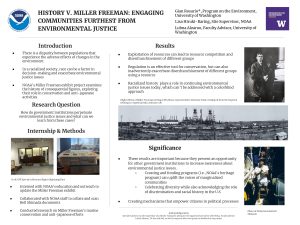HISTORY V. MILLER FREEMAN: WAYS ENVIRONMENTAL COMMUNICATION CAN BETTER ENGAGE DIVERSE COMMUNITIES
The purpose of the study is to examine how government institutions exacerbate environmental justice issues, mainly by exploring the United States’ racial history and how it intersects and perpetuates today’s environmental justice issues. Looking at history and its connection to current environmental justice issues, we can learn to prevent similar issues from reoccurring and create a more inclusive environment. The National Oceanic and Atmosphere Administration (NOAA) Miller Freeman/Bell Shimada exhibit project explores the role of Miller Freeman as a publicist who advocated for marine conservation and the exclusion of people of Japanese descent on the West Coast. The internship aims to update a physical exhibit on the NOAA Ship Miller Freeman to include left-out history and reflect the diversity of NOAA’s workforce. To accomplish this task, I researched and collated Miller Freeman’s marine conservation efforts and anti-Japanese, as well as Bell Shimada’s contributions to NOAA. Main evidence collection methods included collaboration with NOAA staff, who provided documents such as family collection photos and documents that corroborated timeline events, research at the UW library collections/digital archives, NOAA Western Regional Center Library, and visiting NOAA sites such as the Montlake lab, which contained historical materials.
